N-BK7 Plano-Convex Lenses (High Power, V-Coated: 633 nm)

- Positive Focal Length and Near Best Form for Infinite Conjugate Applications
- AR V-Coats: 633 nm
- R < 0.25% at 633 nm
LA1509-633
(Ø1")
LA1074-633
(Ø1/2")

Please Wait
| Common Specifications | |
|---|---|
| Lens Shape | Plano-Convex |
| Substrate Material | N-BK7 (Grade A)a |
| Coating (V-Coat) | 633 nm |
| Diameters Available | 1/2" or 1" |
| Diameter Tolerance | +0.00/-0.10 mm |
| Thickness Tolerance | ±0.1 mm |
| Focal Length Tolerance | ±1% |
| Surface Quality | 20-10 Scratch-Dig |
| Design Wavelength | 587.6 nm |
| Index of Refraction @ 633 nm | 1.515 |
| Reflectance @ 633 nm | <0.25% |
| Surface Flatness (Plano Side) |
λ/2 |
| Spherical Surface Powerb (Convex Side) |
3λ/2 |
| Surface Irregularity (Peak to Valley) |
λ/4 |
| Abbe # | vd = 64.17 |
| Centration | ≤3 arcmin |
| Clear Aperture | >90% of Diameter |
| Focal Length Tolerance | ±1% |
Features
- Material: N-BK7
- AR V-Coated: 633 nm
- Ø1/2" or Ø1" Plano-Convex Spherical Singlet Lenses
These Plano-Convex Lenses are fabricated from N-BK7 glass and feature laser line V-coats at 633 nm for use with popular high-power HeNe lasers with pulsed outputs up to 10 J/cm2. N-BK7 is a common optical glass that can be used for high-quality optical components. It is typically chosen whenever the additional benefits of UV fused silica (i.e., good transmission further into the UV and a lower coefficient of thermal expansion) are not necessary.
These plano-convex lenses are popular for many applications. They have a positive focal length and near-best-form shape for infinite and finite conjugate applications. Plano-convex lenses focus a collimated beam to the back focus and collimate light from a point source.
To minimize the introduction of spherical aberration, a collimated light source should be incident on the curved surface of the lens when being focused and a point light source should be incident on the planar surface when being collimated. The focal length of each lens can be calculated using a simplified thick lens equation. f= R/(n-1), where n is the index of refraction and R is the radius of curvature of the lens surface. These lenses are fabricated from N-BK7, which has an Abbe Number of 64.17; this value is an indicator of the dispersion.
V-Coating:
V-coating is a multilayer, antireflective, dielectric, thin-film coating that achieves lower reflectance over a narrower bandwidth when used within their design AOI range. Reflectance rises rapidly on either side of this minimum, giving the reflectance curve a “V” shape (see Graphs tab for performance plots). When compared to broadband AR offerings, dielectric V-coats achieve lower reflectance over a narrower bandwidth.
With a reflectance of less than 0.25% at the coating wavelength, these lenses provide exceptionally efficient transmittance and are ideal for use with HeNe lasers, as well as applications where light is transmitted through complex optical systems. Durable and capable of withstanding up to 10 J/cm2 (10 ns, 10 Hz), these V-coated spherical singlets are also particularly well-suited for high-power applications.
| Other N-BK7 Plano-Convex V-Coats | ||||||
|---|---|---|---|---|---|---|
| 780 nm | ||||||
| 532 / 1064 nm | ||||||
| Quick Links to Other Spherical Singlets | ||||||
|---|---|---|---|---|---|---|
| Plano-Convex | Bi-Convex | Best Form | Plano-Concave | Bi-Concave | Positive Meniscus | Negative Meniscus |
Below is the transmission curve for N-BK7, a RoHS-compliant form of BK7. Total transmission is shown for a 10 mm thick, uncoated sample and includes surface reflections. Each N-BK7 lens presented here can be ordered with a 532/1064 nm, 633 nm, or 780 nm laser line V-coating.
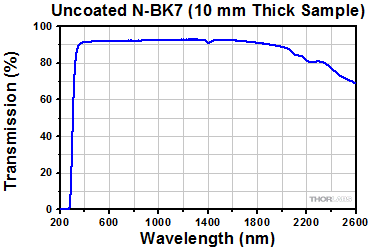
Click to Enlarge
Click Here for Raw Data
V-Coating
The V-coating is a multilayer, anti-reflective, dielectric thin-film coating designed to achieve minimal reflectance over a narrow band of wavelengths. Reflectance rises rapidly on either side of this minimum, giving the reflectance curve a “V” shape, as shown in the following performance plots. Thorlabs' V-coats have a minimum reflectance of less than 0.25% per surface at the coating wavelength and are designed for angles of incidence (AOI) between 0° and 20°. Compared to our broadband AR coatings, V-coatings achieve lower reflectance over a narrower bandwidth when used at the specified AOI.
633 nm V-Coat Reflectance (AOI: 0 - 20°)
The plot on the right is an enlarged view of the shaded region:
Other AR Coatings
Thorlabs offers N-BK7 plano-convex lenses with other V-coatings:
- -YAG V-Coating (532/1064 nm)
- -633 V-Coating (633 nm)
- -780 V-Coating (780 nm)
They are also available with the broadband dielectric AR coatings whose performance is shown in the graph below. Click here to view our full selection of coatings for N-BK7 plano-convex lenses.
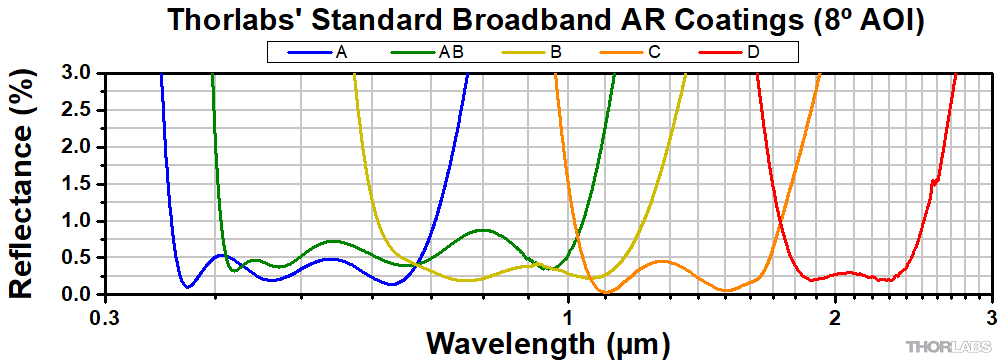
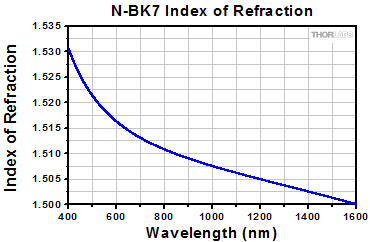
Click to Enlarge
Click Here for Raw Data
In the thick lens equation, use the index of refraction for N-BK7 at the wavelength of interest to approximate the wavelength-dependent focal length of any of the plano-convex lenses.
The focal length of a thick spherical lens can be calculated using the thick lens equation below. In this expression, nl is the index of refraction of the lens, R1 and R2 are the radii of curvature for surfaces 1 and 2, respectively, and d is the center thickness of the lens.
 .
.
When using the thick lens equation to calculate the focal length of a plano-convex lens, R1 = ∞ and R2 = -R. Note that the minus sign in front of R is due to the sign convention used when deriving the thick lens equations. Therefore, via substitution, the thick lens equation becomes
 .
.
The focal length of the lens calculated using the simplified thick lens equation directly above is the distance between the second (back) principal plane (H") and the position at which a collimated beam incident on the curved surface of the plano-convex is focused. The principle plane positions of a thick lens can be calculated with the following equations:
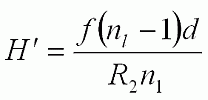 and
and  .
.
However, as with the thick lens equation, H' simplifies to zero and H" simplifies to

when used to calculate the principle plane locations of plano-convex lenses. fb is the back focal length of the lens, which is often referred to as the working distance of the lens.
| Recommended Mounting Options for Thorlabs Lenses | ||
|---|---|---|
| Item # | Mounts for Ø2 mm to Ø10 mm Optics | |
| Imperial | Metric | |
| (Various) | Fixed Lens Mounts and Mini-Series Fixed Lens Mounts for Small Optics, Ø5 mm to Ø10 mm | |
| (Various) | Small Optic Adapters for Use with Standard Fixed Lens Mounts, Ø2 mm to Ø10 mm | |
| Item # | Mounts for Ø1/2" (Ø12.7 mm) Optics | |
| Imperial | Metric | |
| LMR05 | LMR05/M | Fixed Lens Mount for Ø1/2" Optics |
| MLH05 | MLH05/M | Mini-Series Fixed Lens Mount for Ø1/2" Optics |
| LM05XY | LM05XY/M | Translating Lens Mount for Ø1/2" Optics |
| SCP05 | 16 mm Cage System, XY Translation Mount for Ø1/2" Optics | |
| (Various) | Ø1/2" Lens Tubes, Optional SM05RRC Retaining Ring for High-Curvature Lenses (See Below) |
|
| Item # | Mounts for Ø1" (Ø25.4 mm) Optics | |
| Imperial | Metric | |
| LMR1 | LMR1/M | Fixed Lens Mount for Ø1" Optics |
| LM1XY | LM1XY/M | Translating Lens Mount for Ø1" Optics |
| ST1XY-S | ST1XY-S/M | Translating Lens Mount with Micrometer Drives (Other Drives Available) |
| CXY1A | 30 mm Cage System, XY Translation Mount for Ø1" Optics | |
| (Various) | Ø1" Lens Tubes, Optional SM1RRC Retaining Ring for High-Curvature Lenses (See Below) |
|
| Item # | Mount for Ø1.5" Optics | |
| Imperial | Metric | |
| LMR1.5 | LMR1.5/M | Fixed Lens Mount for Ø1.5" Optics |
| (Various) | Ø1.5" Lens Tubes, Optional SM1.5RR Retaining Ring for Ø1.5" Lens Tubes and Mounts |
|
| Item # | Mounts for Ø2" (Ø50.8 mm) Optics | |
| Imperial | Metric | |
| LMR2 | LMR2/M | Fixed Lens Mount for Ø2" Optics |
| LM2XY | LM2XY/M | Translating Lens Mount for Ø2" Optics |
| CXY2 | 60 mm Cage System, XY Translation Mount for Ø2" Optics |
|
| (Various) | Ø2" Lens Tubes, Optional SM2RRC Retaining Ring for High-Curvature Lenses (See Below) |
|
| Item # | Adjustable Optic Mounts | |
| Imperial | Metric | |
| LH1 | LH1/M | Adjustable Mount for Ø0.28" (Ø7.1 mm) to Ø1.80" (Ø45.7 mm) Optics |
| LH2 | LH2/M | Adjustable Mount for Ø0.77" (Ø19.6 mm) to Ø2.28" (Ø57.9 mm) Optics |
| VG100 | VG100/M | Adjustable Clamp for Ø0.5" (Ø13 mm) to Ø3.5" (Ø89 mm) Optics |
| SCL03 | SCL03/M | Self-Centering Mount for Ø0.15" (Ø3.8 mm) to Ø1.77" (Ø45.0 mm) Optics |
| SCL04 | SCL04/M | Self-Centering Mount for Ø0.15" (Ø3.8 mm) to Ø3.00" (Ø76.2 mm) Optics |
| LH160C | LH160C/M | Adjustable Mount for 60 mm Cage Systems, Ø0.50" (Ø13 mm) to Ø2.00" (Ø50.8 mm) Optics |
| SCL60CA | SCL60C/M | Self-Centering Mount for 60 mm Cage Systems, Ø0.15" (Ø3.8 mm) to Ø1.77" (Ø45.0 mm) Optics |
Mounting High-Curvature Optics
Thorlabs' retaining rings are used to secure unmounted optics within lens tubes or optic mounts. These rings are secured in position using a compatible spanner wrench. For flat or low-curvature optics, standard retaining rings manufactured from anodized aluminum are available from Ø5 mm to Ø4". For high-curvature optics, extra-thick retaining rings are available in Ø1/2", Ø1", and Ø2" sizes.
Extra-thick retaining rings offer several features that aid in mounting high-curvature optics such as aspheric lenses, short-focal-length plano-convex lenses, and condenser lenses. As shown in the animation to the right, the guide flange of the spanner wrench will collide with the surface of high-curvature lenses when using a standard retaining ring, potentially scratching the optic. This contact also creates a gap between the spanner wrench and retaining ring, preventing the ring from tightening correctly. Extra-thick retaining rings provide the necessary clearance for the spanner wrench to secure the lens without coming into contact with the optic surface.
| Posted Comments: | |
mohamed.boudhib
(posted 2014-06-19 09:23:23.193) I noticed that your V-Coated lenses (particularly AR 1064/532) are not produced at a diameter of 2". Is it just stock-out ? jlow
(posted 2014-07-14 12:17:00.0) Response from Jeremy at Thorlabs: We do not stock the Ø2" version for these lenses. We can custom make these for you. We will contact you directly regarding this. nkaddy
(posted 2014-03-25 19:19:22.127) I noticed that none of your V-coated lenses come pre-mounted, is there a reason for this? cdaly
(posted 2014-03-25 03:40:33.0) Response from Chris at Thorlabs: We do not stock a mounted version of these lenses because we have not seen a high demand for this. These lenses can easily be mounted in 1 inch lens tube, either SM1L03 or SM1L10 depending on the optic thickness. This would not have engraving of the part number however. If this is needed we can likely provide it as a custom. I will contact directly to discuss this further. |

 Products Home
Products Home






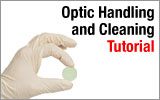
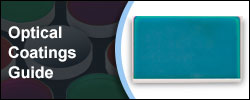
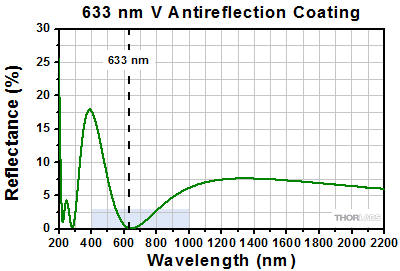
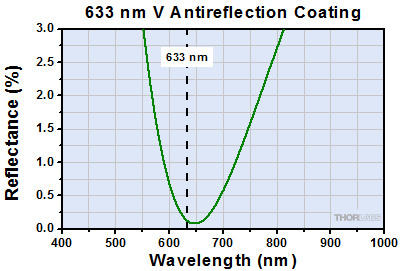
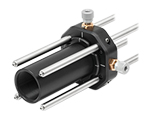
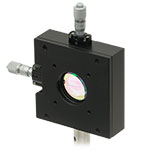
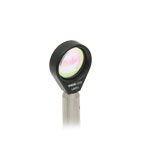

 N-BK7, 633 nm
N-BK7, 633 nm